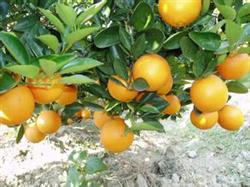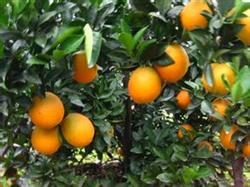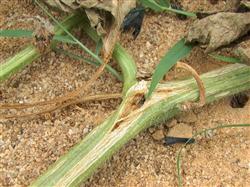Cultivation techniques of Red Meat navel Orange

Compared with Newhall navel orange, Penna navel orange and other navel orange varieties, the yield, fruit appearance and internal quality, adaptability and resistance of red navel orange are similar, but there are three different characteristics: one is the only navel orange variety in the world with red peel and flesh (flesh colored by tomato red), and the fruit is spherical. Second, the maturity period is at the end of December, slightly later than the main navel orange varieties in China (mainly from November to mid-December). Third, the fruit is more resistant to storage, in winter frost-free areas can also hang trees for storage until March of the following year, the flavor is more concentrated. As red symbolizes good luck, red navel orange fruits are very popular in the mainland, Hong Kong and Macao markets. Industry insiders also generally believe that according to the navel orange fruit in the hearts of consumers has formed a position and red navel orange fruit excellent quality, its sales prospects must be broad. Compared with the main navel orange varieties now, the market price of red-flesh navel orange will increase by at least 50%, and the price of fruit as gift fruit and hotel will be doubled. At present, there are 667 hectares of red orange planting area in China, but most of them are young trees without fruit or just bearing fruit. China is now in the period of citrus variety renewal, therefore, the development prospect of red-fleshed navel orange is relatively broad, and its cultivation area has a trend of increasing year by year. In order to better reflect the cultivation potential and commercial value of red-flesh navel orange and avoid the loss caused by blind development, it is necessary to seek the supporting cultivation techniques. According to many years of pilot experience in each district, the cultivation points of red orange are summarized as follows. Grafting experiments showed that red flesh navel orange was compatible with orange, trifoliate orange, pomelo, satsuma orange and sweet orange. At the time of high grafting, single bud ventral grafting (multiple xylem) restores tree vigor and yields quickly. Generally, crown can be restored in two years, and the yield per 667 square meters can reach about 300kg. After 3 years, the yield of each plant is 10~20kg. The most suitable planting area for red flesh navel orange is the area where the accumulated temperature is ≥10℃, the annual accumulated temperature is 5500~6500, and the temperature difference between day and night is large before fruit ripening (from the end of October to November). In the above areas, the best ecological areas for producing high-quality red orange are the areas where there is no frost in winter or the frost comes late (such as after the end of December) and lasts for a short time. According to the development plan of citrus and the characteristics of red-flesh navel orange in China, the most suitable development area of red-flesh navel orange is the middle and upper reaches of Yangtze River, which can be developed as a main fresh variety or one of the main varieties. The total development area can reach 13 ~ 20,000 hectares. The harvest period can be from the end of December to March of the next year. The fresh fruit market supply period can be around the Spring Festival. Secondly, in southern Jiangxi, southern Hunan, northern Guangxi and Fujian, Guangdong, etc. as the main flower varieties to develop, the total development area should not exceed 20,000 hectares (due to the large development base in this area), fresh fruit mainly supply the market before the Spring Festival. The cultivation effect and benefit of garden site selection were the best in gentle slope land and hilly land without drought and flood. When new orchards of red-flesh navel orange are built, the shallow soil layer should be drained and sufficient base fertilizer should be applied; mature orchards should be deeply ploughed regularly to improve the soil. The fruit of red flesh navel orange is sensitive to water deficit when it expands. Pay attention to the construction of irrigation and drainage facilities and annual balanced irrigation, especially in dry season. Choose big seedlings and strong seedlings for planting with soil. 74 plants (plant spacing 3m~3m) should be planted in 667 square meters of mountain orange garden, and 56 plants (plant spacing 3m×4m) should be planted in 667 square meters of flat and gentle slope orange garden. Red flesh navel orange has strong budding ability, tender shoots are easy to droop, flower buds are easy to differentiate, attention should be paid to early, and the trunk height should be 40~60cm. In order to avoid excessive and small fruits after fruiting, attention should be paid to thinning flowers and fruits, controlling summer shoots and wiping late autumn shoots, properly promoting spring shoots and early autumn shoots, pruning trees after fruit picking or before germination, thinning cluster branches, so as to ensure ventilation and light transmission of trees and make fruits beautiful in appearance. Cloudy weather at flowering stage has great influence on the yield of red-fleshed navel orange. At this time, attention should be paid to shaking trees and falling flowers. On the one hand, it can play the role of thinning flowers, on the other hand, it can shake petals adhered to young fruits to prevent them from being moldy and rotten, affecting fruit or causing scars on fruits. When breeding seedlings, scion as far as possible to use spring shoots, grafting with a little more xylem. Pest control methods are the same as other citrus varieties.
- Prev

Key points and points for attention in cultivation techniques of Red Meat navel Orange
Red meat navel orange, also known as Caracara navel orange. 1. Adaptability and suitable planting area: good heat condition, navel orange suitable planting area with large temperature difference between day and night from the end of October to November before fruit ripening, and suitable for planting after the end of December or short time in winter frost or frost. two。 Key points of cultivation techniques and attention.
- Next

How to prevent and cure spring watermelon
In recent years, watermelon in protected areas in Jiangsu Province has developed rapidly. due to the more overcast and rainy weather during the growth period, it provides favorable conditions for the occurrence of watermelon vine blight, and the incidence is aggravated year by year. Watermelon vine blight mainly harms stems and vines, as well as leaves and fruits. Melon vine damage, mostly in the near ground stem node disease, the first dark green.
Related
- Moge, come on! The staff of the peasant association in the producing area of cantaloupe were frightened when the crowd gathered.
- Causes and Solutions of low Fruit setting rate of Apple
- Symptoms and control measures of passion fruit virus disease
- Fruit growing lesson: how do apple orchards keep high yields?
- Can you build orchards in the mountains? What are the pros and cons?
- How to manage the coloring period of Crisson grape?
- This paper introduces the processing technology of two kinds of fig products.
- How much is a month for retired teachers in rural areas by 2020?
- How can strawberry planting increase sugar content? We should pay attention to management in many aspects.
- What are the cultivation techniques on how to improve the yield of golden fruit?

